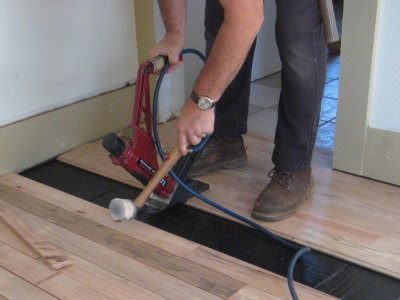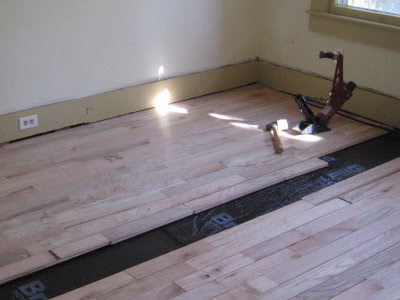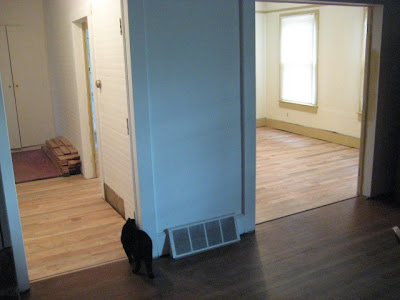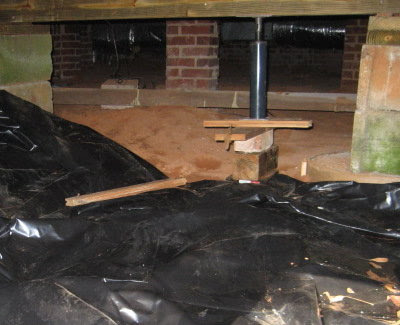Dan and I used to have a private joke. I love books (we both do), and when I could find a good bargain for something we were interested in, I would get it. Then I would show it to him, and he would invariably respond, "Nooooo! Now we have to move it!" This was because he used to drive for a local moving company, which meant not only driving, but also packing boxes, loading and unloading the truck. As you can imagine, moving households that owned a lot of books meant a long, back-breaking day's labor.
The other day, when I was showing him my latest purchases, he put his hand on my shoulder, looked me in the eye, and said, "You can buy as many books as you want." We both laughed because this is our forever home which means we aren't planning to ever move again.
He doesn't have to worry about me going hog wild of course, because I major in frugalness. That means I am careful with what I choose to buy, and I only buy if I can get it on sale or discounted. Since we've moved here, I've added quite a few good books to our home library, and almost all of them are tools to help us fulfill our dream.
It's funny because while I was working on this post, Theresa over at Camp Runamuck
asked her readers about their reading lists, so I can offer these as mine. You can click on any book cover for a closer look.
 Nourishing Traditions: The Cookbook that Challenges Politically Correct Nutrition and the Diet Dictocrats
Nourishing Traditions: The Cookbook that Challenges Politically Correct Nutrition and the Diet Dictocrats by Sally Fallon. I mentioned this book in my recent
ginger carrot post. Besides being a cookbook, this book offers a complete dietary model for healthy living. It begins with a discussion of the nutrients and their food sources, and then goes on to a chapter on "Mastering The Basics." These include cultured dairy products, fermented fruits and vegetables, sprouting grains, nuts & seeds, stocks, salad dressings, sauces, marinades, condiments, and about coconut products. Ther rest of the book covers every category of recipe you can imagine, including a chapter on feeding babies. Lots of interesting informational tidbits are to be found in the sidebars.
I don't agree with everything she says, but even so, this has been a mind blowing book for me.
 Wild Fermentation: The Flavor, Nutrition, and Craft of Live-Culture Foods
Wild Fermentation: The Flavor, Nutrition, and Craft of Live-Culture Foods by Sandor Ellix Katz. Sandor approaches the subject from a cultural point of view: cultural context, cultural rehabilitation, cultural theory, cultural homogenization, and cultural manipulation. I don't agree with all of his conclusions, but he writes intelligently and makes some good points. Chapters include: Vegetable Ferments, Bean Ferments, Dairy Ferments (and Vegan Alternatives), Breads, Fermented Grain Porridges and Beverages, Wines (Including Mead, Cider, and Ginger Beer), Beers, and Vinegars. Lots of good recipes here.
Sandor also has a website and fermentation forum at
http://www.wildfermentation.com/

This is another one I
mentioned previously,
Preserving Food without Freezing or Canning: Traditional Techniques Using Salt, Oil, Sugar, Alcohol, Vinegar, Drying, Cold Storage, and Lactic Fermentation
by The Gardeners & Farmers of Terre Vivante. This one was the precursor to the two above.
Besides the chapter on preserving with lactic fermentation, other chapters cover preserving by root cellaring, by drying, in oil, with salt, with sugar, in alcohol, and sweet & sour preserves. A chart at the back of the book indicates which methods are best for which foods.

DH was interested in this one,
Smoking Food: A Beginner's Guide
, by Chris Dubbs and Dave Heberle. We're nowhere near ready to build our own smoker, but like most things on discount, I've learned to buy it when I find it. The book covers types of smokers, with instructions on how to make your own, various fuels, other equipment, materials, cures, hot vs. cold smoking, and marinades. Then it discusses the how-tos of smoking fish, seafood, butcher meat (i.e. pork and beef), poultry, wild game, making and smoking sausage, and lastly smoking cheese, nuts, and eggs. Appendices discuss troubleshooting, herbs and spices, and tips on handling game (deer, rabbit, bear, squirrel, opossum, woodchuck, etc.)

This is another book that's really broadening my thinking about our little homestead,
Small-Scale Grain Raising: An Organic Guide to Growing, Processing, and Using Nutritious Whole Grains for Home Gardeners and Local Farmers, 2nd Edition
by Gene Logsdon. His sense of humor makes this fun to read (ever heard of a pancake patch?) For the first time I can actually see myself raising grain. Look forward to some experiments next summer!
Chapters discuss corn, wheat, the sorghums, oats, dry beans, rye, barley, buckwheat, millet, legumes, rice, and feeding grains to animals. One chapter is dedicated to more unusual grains like wild rice, triticale (a wheat/rye cross), spelt, farro, quinoa, and flax. Each chapter contains some good looking recipes as well.
Published in 2009, I don't agree with him that the jury's still out on GMO grains, but he does endorse open pollinated seed in order to save it. Informative charts are sprinkled throughout the book: cooking chart, bushel chart, and crop rotation plans. An illustrated glossary shows and explains the various tools needed form homegrowing grains.
 Handy Farm Devices and How to Make Them
Handy Farm Devices and How to Make Them
by Rolfe Cobleigh is a reprint from 1910. It wasn't very expensive and I figured that even if it didn't contain something of use to us here on the homestead, it would be of historical interest at least. I wasn't disappointed, I got both. Devices are discussed by type, which are divided into chapters. For example: Workshop and Tools, In and Around the House, Barns and Stock, Poultry and Bees, Garden and Orchard, Field and Wood, and Gates and Doors. The devices themselves? How about: a potato sorter, a stump puller, a rack for seed corn, a wheelbarrow sheep trough, a fire warning device, an elevated clothes line, a device for extracting beeswax, and a gate to overcome snowdrifts, to name just a few.
This particular reprint is from Skyhorse Publishing, but Dover also reprints it under the title,
Old-Time Farm and Garden Devices and How to Make Them
.

I mailordered
Fuel Cell Projects for the Evil Genius
by Gavin D. J. Harper because it is about hydrogen as an energy source. However, it wasn't what we hoped it would be. it Oh, it's a very good book, and I wish I'd had it for DS back when we were homeschooling our way through high school science. In fact, it would be perfect for that because it is geared toward small hydrogen fueled DIY projects, some of which we may still be able to apply practically around the place. Or at least gain a better understanding in order to apply the knowledge on a larger scale.
Chapter 1 is a history of the discovery of hydrogen and the development of fuel cells. Chapter 2 is entitled "the Hydrogen Economy" which explains why hydrogen as an energy source is important to explore. The remaining chapters discuss and provide projects for making and storing hydrogen, different types of fuel cells ( platinum, alkaline, PEM, methanol, microbial, high-temp. and scratch-built. Hydrogen safety, transport, and fuel cell competitions round out the book.

I bought
The Amish Cookbook when we were at the Shady Maple Gift Shop on our
trip to Pennsylvania. It contains over 1000 recipes from 14 states, and so probably gives a pretty good idea of a typical Amish diet. This is not a health or natural food cookbook, and some of the recipes contain ingredients I don't use such as Jello, shortening, Velveeta cheese, salt petre, to name a few. However, I don't think there is a recipe in there that one couldn't substitute preferred alternative ingredients.
The reason I got it was for the chapter on canning and preserving. When I saw it contained several recipes for canning homemade bologna, I decided to buy it. (Not to mention that I probably would have regretted
not getting it once we left the shop.) I've also appreciated the chapter on pickles and relishes, and as of this writing, have realized that it contains cheesemaking recipes as well.
 Weaving As An Art Form: A Personal Statement
Weaving As An Art Form: A Personal Statement by Theo Moorman, was on sale as a surplus copy from my
weaving guild's library sale. I bought it as a source of inspiration, because one of these days (after the
dining room floor gets done and I can have
my studio back), I will get back to
my fiber arts. The title appealed to me, because I am an artist whose medium is fiber, and someday I hope to abandon functional weaving and weave strictly as an artistic statement. The author appealed to me, because Theo Moorman is well known in the weaving world. The introduction appealed to me, for it was there that I read, "..... I seem, in my work as a weaver and designer, only able to gain ground through a mass of experiments, blunders, and muddles." That's me in a nutshell. I have been in the learning and exploratory stage of the various weave structure and techniques for almost ten years, not counting long term breaks to attend to other areas of need and interest. And of course, the content of the book appealed to me, for it discusses the technique for which the author is famous, The Moorman Technique, which simply put, is a type of inlay. So this book is on my reading list, probably not in the near future, but in the future nonetheless.
Where do I get my books? Well, Amazon.com, of course. Also from the numerous
Dover catalogues we get. Dover reprints a lot of old books and sells them at reasonable prices, plus they often have sales and specials. Also, I buy a lot of books from my
Edward R. Hamilton Bookseller Company catalogues. If you click on their name it will take you to their website, but they do charge an additional 40 cents per book if ordered with a credit card via the website, so I prefer ordering from their catalogue. They have a standard $3.50 shipping no matter how many books are ordered, which is very reasonable.
In addition to the above, I have three more books on order!
From Hamilton:
Home Cheese Making: Recipes for 75 Homemade Cheeses
by Ricki Carroll
Living Off the Grid: A Simple Guide to Creating and Maintaining a Self-Reliant Supply of Energy, Water, Shelter, and More
by Dave Black
From Amazon:
The Complete Medicinal Herbal: A Practical Guide to the Healing Properties of Herbs, with More Than 250 Remedies for Common Ailments
by Penelope Ody
Did I also mention that I love books? And until these arrive, I will love going out to look in the mailbox every day. :)
 We put down tongue and groove oak, 3.25 inches wide (real width), 3/4 inch thick. The first course was face-nailed next to the baseboard where the nails will be covered with quarter-round trim. This meant holes had to be drilled and the nails hammered by hand. The string served as a guide to get the first couple of rows in evenly. After that we just kept going. We did pretty well because the difference was only 1/8 inch off by the time we got to the other side of the room.
We put down tongue and groove oak, 3.25 inches wide (real width), 3/4 inch thick. The first course was face-nailed next to the baseboard where the nails will be covered with quarter-round trim. This meant holes had to be drilled and the nails hammered by hand. The string served as a guide to get the first couple of rows in evenly. After that we just kept going. We did pretty well because the difference was only 1/8 inch off by the time we got to the other side of the room. We rented a pneumatic nailer for this job. It is hooked up to an air compressor, but the nails are popped in manually with a mallet. One side of the mallet is used to tap the board into place (as above), the other is used to hit the "trigger."
We rented a pneumatic nailer for this job. It is hooked up to an air compressor, but the nails are popped in manually with a mallet. One side of the mallet is used to tap the board into place (as above), the other is used to hit the "trigger." I've never helped put down an hardwood floor before, so I was surprised at the nails used (photo left). They are shot into the tongue of each row and so are hidden by the groove of the adjacent row of boards.
I've never helped put down an hardwood floor before, so I was surprised at the nails used (photo left). They are shot into the tongue of each row and so are hidden by the groove of the adjacent row of boards.

 The doorway between the dining room and hall once had a door, but it was gone before we got here. We plan to leave it open, so no threshold is necessary here.
The doorway between the dining room and hall once had a door, but it was gone before we got here. We plan to leave it open, so no threshold is necessary here. The blue ribbon dangling from the dining room light, BTW, was put there by Dan because I kept hitting my head on it when I was laying out the floor. I thought is was a silly idea, but I never hit my head on it again, so it worked!
The blue ribbon dangling from the dining room light, BTW, was put there by Dan because I kept hitting my head on it when I was laying out the floor. I thought is was a silly idea, but I never hit my head on it again, so it worked! Still to do:
Still to do:













































